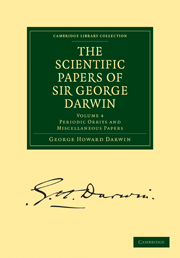Book contents
- Frontmatter
- PREFACE
- Contents
- Chronological List of Papers with References to the Volumes in which they are contained
- Errata
- PART I PERIODIC ORBITS
- PART II THE TIDES
- PART III MISCELLANEOUS PAPERS IN CHRONOLOGICAL ORDER
- PART IV PAPERS ON TIDES (Supplementary to Volume I)
- PART V ADDRESSES TO SOCIETIES
- 24 Geological Time
- 25 Presentation of the Medal of the Royal Astronomical Society to M. Henri Poincaré
- 26 Cosmical Evolution
- APPENDIX
- INDEX
- Plate section
24 - Geological Time
Published online by Cambridge University Press: 07 September 2010
- Frontmatter
- PREFACE
- Contents
- Chronological List of Papers with References to the Volumes in which they are contained
- Errata
- PART I PERIODIC ORBITS
- PART II THE TIDES
- PART III MISCELLANEOUS PAPERS IN CHRONOLOGICAL ORDER
- PART IV PAPERS ON TIDES (Supplementary to Volume I)
- PART V ADDRESSES TO SOCIETIES
- 24 Geological Time
- 25 Presentation of the Medal of the Royal Astronomical Society to M. Henri Poincaré
- 26 Cosmical Evolution
- APPENDIX
- INDEX
- Plate section
Summary
A mere catalogue of facts, however well arranged, has never led to any important scientific generalisation. For in any subject the facts are so numerous and many-sided that they only lead us to a conclusion when they are marshalled by the light of some leading idea. A theory is then a necessity for the advance of science, and we may regard it as the branch of a living tree, of which facts are the nourishment. In the struggle between competing branches to reach the light some perish, and others form vigorous limbs. And as in a tree the shape of the young shoot can give us but little idea of the ultimate form of the branch, so theories become largely transformed in the course of their existence, and afford in their turn the parent stem for others.
The success of a theory may be measured by the extent to which it is capable of assimilating facts, and by the smallness of the change which it must undergo in the process. Every theory which is based on a true perception of facts is to some extent fertile in affording a nucleus for the aggregation of new observations. And a theory, apparently abandoned, has often ultimately appeared to contain an element of truth, which receives acknowledgment by the light of later views.
- Type
- Chapter
- Information
- The Scientific Papers of Sir George DarwinPeriodic Orbits and Miscellaneous Papers, pp. 499 - 509Publisher: Cambridge University PressPrint publication year: 2009First published in: 1911

